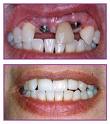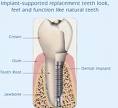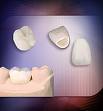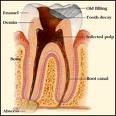
Dr Krutika jani (BDS, PGDHM) Dr Dhaval Jani (MDS)
DENTAL CLINIC

NAVDANT DENTAL LASER AND IMPLANT CENTER
Saturday, September 10, 2011
Laser Dentistry...

Laser Dentistry...
WE AT GARG DENTAL CLINIC HAVING FIRST DENTAL LASER IN BHAVNAGAR DISTRICT...
With the advancements in the field of dentistry, laser dentistry is being recognised and adopted by many cosmetic dentists. These new techniques are being appreciated and many patients are going in for laser treatment.
The laser technology is a sophisticated technology which is being used to treat dental problems like gum disease and tooth decay.
The thought of visiting the dentist to get a cavity filled or for root canal has always been associated with tension. But with new technologies, people no longer fear dental care as it is less painful. Cosmetic dentists are able to treat patients successfully. The results are also positive. Laser dentistry is being adopted for dental treatments like teeth whitening. Under the latest techniques of laser treatment, the patient is not anaesthetised for minor dental treatments. The patient also does not experience any major pain at the time of the treatment.
Some of the major benefits of laser dentistry are that patients do not experience soreness or tenderness of gums or teeth. The laser technology is hi- tech and sophisticated, so there is a lesser chance of bacterial infections. The healing is much quicker and there is faster regeneration of tissues.
Sunday, July 31, 2011
Laser Dentistry
What is Laser Dentistry?
What is a laser and how does it work? A laser is an instrument that produces a very narrow, intense beam of light energy. When laser light comes in contact with tissue, it causes a reaction. The light produced by the laser can remove, vaporize, or shape tissue.
Are lasers used in dentistry?
Yes, lasers have been used in dentistry since 1990. The U.S. Food and Drug Administration has determined that lasers can be used as a safe and effective treatment for a wide range of dental procedures. Lasers are often used in conjunction with other dental instruments.
How are lasers used in dentistry?
Dental lasers can be used to:
* correct speech problems caused by a tongue-tie, which prevents normal tongue movement.
* uncover partially erupted wisdom teeth.
* remove decay from a cavity and prepare the tooth for a new filling.
* remove muscle pulls, as seen in orthodontic patients.
* manage gum tissue during impressions for crowns.
* remove swollen tissues caused by medications.
* perform biopsy procedures.
* remove inflamed gum tissues and reduce the amount of bacteria within a periodontal pocket.
* remove or reshape excess gum and bone tissues during crown lengthening procedures.
* treat abscessed gums and infections in root canals.
* reduce the discomfort of canker and cold sores.
* activate whitening chemicals that are used to lighten teeth.
What are the benefits of using dental lasers?
There are several advantages. Dentists may not need to use a drill or administer anesthesia, allowing the patient to enjoy a more relaxed dental experience. Laser procedures can be more precise. Also, lasers can reduce symptoms and healing times associated with traditional therapies; reduce the amount of bacteria in both diseased gum tissue and in tooth cavities; and control bleeding during surgery.
Are dental lasers safe?
If the dental laser is used according to accepted practices by a trained practitioner, then it is at least as safe as other dental instruments. However, just as you wear sunglasses to protect your eyes from prolonged exposure to the sun, when your dentist performs a laser procedure, you will be asked to wear special eyeglasses to protect your eyes from the laser.
How can I be sure my dentist is properly trained to use a laser?
Ask your dentist questions about the extent of his or her laser education and training. Make sure that your dentist has participated in educational courses and received training by the manufacturer. Many dental schools, dental associations, and the Academy of Laser Dentistry (ALD) offer dental laser education. The ALD is the profession's independent source for current dental laser education and credentialing.
How will I know if treatment with a dental laser is an option for me?
Ask your dentist. Although the laser is a very useful dental instrument, it is not appropriate for every dental procedure.
Wednesday, February 2, 2011
Dental Implants
Dental Implants

Dental Implants: Teeth That Look and Feel Like Your Own
A dental implant is an artificial tooth root that a implantologist places into your jaw to hold a replacement tooth or bridge. Smile 'n' Shine Dental Care Centre speciality implant centre which is equipped with the most modern instruments for oral implants placements. Dental implants are an ideal option for people in good general oral health who have lost a tooth or teeth due to periodontal disease, an injury, or some other reason.
While high-tech in nature, dental implants are actually more tooth-saving than traditional bridgework, since implants do not rely on neighboring teeth for support.
Dental implants are so natural-looking and feeling, you may forget you ever lost a tooth. You know that your confidence about your teeth affects how you feel about yourself, both personally and professionally. Perhaps you hide your smile because of spaces from missing teeth. Maybe your dentures don't feel secure. Perhaps you have difficulty chewing. If you are missing one or more teeth and would like to smile, speak and eat again with comfort and confidence, there is good news! Dental implants are teeth that can look and feel just like your own! Under proper conditions, such as placement by a periodontist and diligent patient maintenance, implants can last a lifetime. Long-term studies continue to show improving success rates for implants.

What Dental Implants Can Do?
- Replace one or more teeth without affecting bordering teeth.
- Support a bridge and eliminate the need for a removable partial denture.
- Provide support for a denture, making it more secure and comfortable.

Types of Implants in Use Today
- Endosteal (in the bone): This is the most commonly used type of implant. The various types include screws, cylinders or blades surgically placed into the jawbone. Each implant holds one or more prosthetic teeth. This type of implant is generally used as an alternative for patients with bridges or removable dentures.
- Subperiosteal (on the bone): These are placed on top of the jaw with the metal framework's posts protruding through the gum to hold the prosthesis. These types of implants are used for patients who are unable to wear conventional dentures and who have minimal bone height.

Advantages of Dental Implants Over Dentures or a Bridge
Every way you look at it, dental implants are a better solution to the problem of missing teeth.
- Esthetic Dental implants look and feel like your own teeth! Since dental implants integrate into the structure of your bone, they prevent the bone loss and gum recession that often accompany bridgework and dentures. No one will ever know that you have a replacement tooth.
- Tooth-saving Dental implants don't sacrifice the quality of your adjacent teeth like a bridge does because neighboring teeth are not altered to support the implant. More of your own teeth are left untouched, a significant long-term benefit to your oral health!
- Confidence Dental implants will allow you to once again speak and eat with comfort and confidence! They are secure and offer freedom from the irksome clicks and wobbles of dentures. They'll allow you to say goodbye to worries about misplaced dentures and messy pastes and glues.
- Reliable The success rate of dental implants is highly predictable. They are considered an excellent option for tooth replacement.

Are You a Candidate for Dental Implants?
The ideal candidate for a dental implant is in good general and oral health. Adequate bone in your jaw is needed to support the implant, and the best candidates have healthy gum tissues that are free of periodontal disease.
Dental implants are intimately connected with the gum tissues and underlying bone in the mouth. Since periodontists are the dental experts who specialize in precisely these areas, they are ideal members of your dental implant team. Not only do periodontists have experience working with other dental professionals, they also have the special knowledge, training and facilities that you need to have teeth that look and feel just like your own.
Your dentist and periodontist will work together to make your dreams come true.
What Is Treatment Like?
This procedure is a team effort between you, your dentist and your periodontist. Your periodontist and dentist will consult with you to determine where and how your implant should be placed. Depending on your specific condition and the type of implant chosen, your periodontist will create a treatment plan tailored to meet your needs. Click for more information about the treatment options described below.
- Replacing a Single Tooth If you are missing a single tooth, one implant and a crown can replace it. A dental implant replaces both the lost natural tooth and its root.
- Replacing Several Teeth If you are missing several teeth, implant-supported bridges can replace them. Dental implants will replace both your lost natural teeth and some of the roots.
- Replacing All of Your Teeth If you are missing all of your teeth, an implant-supported full bridge or full denture can replace them. Dental implants will replace both your lost natural teeth and some of the roots.
- Sinus Augmentation A key to implant success is the quantity and quality of the bone where the implant is to be placed. The upper back jaw has traditionally been one of the most difficult areas to successfully place dental implants due to insufficient bone quantity and quality and the close proximity to the sinus. Sinus augmentation can help correct this problem by raising the sinus floor and developing bone for the placement of dental implants.
- Ridge Modification Deformities in the upper or lower jaw can leave you with inadequate bone in which to place dental implants. To correct the problem, the gum is lifted away from the ridge to expose the bony defect. The defect is then filled with bone or bone substitute to build up the ridge. Ridge modification has been shown to greatly improve appearance and increase your chances for successful implants that can last for years to come.
What Can I Expect After Treatment?
As you know, your own teeth require conscientious at-home oral care and regular dental visits. Dental implants are like your own teeth and will require the same care. In order to keep your implant clean and plaque-free, brushing and flossing still apply!
After treatment, your periodontist will work closely with you and your dentist to develop the best care plan for you. Periodic follow-up visits will be scheduled to monitor your implant, teeth and gums to make sure they are healthy.
Fixed Partial Denture
Fixed - Partial Denture

If something unfortunate happens to your teeth, it is important to consult, your dentist to minimize the impact on your entire mouth. Missing teeth can allow the surrounding teeth to become displaced. Cracked or damaged teeth should be fixed to save as much of the tooth as possible.

By taking care of dental problems immediately, you minimize the risk of future problems.
- Crowns fix and protect teeth that are so damaged or diseased that they need more support than a simple filling.
- Bridges replace missing teeth and offer support for the surrounding teeth to help retain the integrity of the jaw and face structure.
Dental Bridges
 Crowns, also known as caps, restore damaged teeth and mimics the shape, size and color of the surrounding teeth. Crowns are indicated for cracked teeth and teeth with deep cavities; to protect teeth that have been filled by root-canal treatment; to provide extra support for bridges; and to cover poorly shaped or discolored teeth. Crowns may be made of metal, porcelain, or newer restorative materials like metal free ceramics. They are custom-made and fitted for each patient in conformation with the size and length of the natural teeth. Crowns typically last five to eight years, but can last much longer with proper oral hygiene. Crowns can be made of a variety of materials. They can be made of plastic, ceramic or metal alloys. A combination of metal and ceramic is also possible to maximize strength and simulate the appearance of natural teeth.
Crowns, also known as caps, restore damaged teeth and mimics the shape, size and color of the surrounding teeth. Crowns are indicated for cracked teeth and teeth with deep cavities; to protect teeth that have been filled by root-canal treatment; to provide extra support for bridges; and to cover poorly shaped or discolored teeth. Crowns may be made of metal, porcelain, or newer restorative materials like metal free ceramics. They are custom-made and fitted for each patient in conformation with the size and length of the natural teeth. Crowns typically last five to eight years, but can last much longer with proper oral hygiene. Crowns can be made of a variety of materials. They can be made of plastic, ceramic or metal alloys. A combination of metal and ceramic is also possible to maximize strength and simulate the appearance of natural teeth.
![]()
 The teeth to be crowned are prepared which involves reduction of the tooth size (usually under local anaesthesia) followed by an impression or mould of the prepared tooth. This trimming of the tooth is required to create space for the crown to be fitted. The mould taken is then sent to a laboratory where skilled technicians will fabricate the crown. In the meanwhile, a temporary crown is made and fitted onto the trimmed tooth.
The teeth to be crowned are prepared which involves reduction of the tooth size (usually under local anaesthesia) followed by an impression or mould of the prepared tooth. This trimming of the tooth is required to create space for the crown to be fitted. The mould taken is then sent to a laboratory where skilled technicians will fabricate the crown. In the meanwhile, a temporary crown is made and fitted onto the trimmed tooth.
Dental Bridges
 A bridge stabilizes the bite of a patient who is missing one or more teeth. Bridges prevent the surrounding teeth from moving or shifting in the mouth. A missing tooth that is not replaced may cause surrounding teeth to become unstable and require removal, compromising oral health or change the shape of the face and diminish the beauty of a smile.
A bridge stabilizes the bite of a patient who is missing one or more teeth. Bridges prevent the surrounding teeth from moving or shifting in the mouth. A missing tooth that is not replaced may cause surrounding teeth to become unstable and require removal, compromising oral health or change the shape of the face and diminish the beauty of a smile.
Unlike partial dentures, bridges are permanent; patients need not remove them. The missing tooth is replaced with an artificial tooth connected between two crowns (caps), which are permanently cemented or bonded on the adjacent teeth.
Bridges can be used to replace a small number of missing teeth if the neighboring teeth are sufficiently strong. The number of missing teeth, condition of the neighboring teeth, condition of the supporting gums and bone are all important factors which need to be assessed prior to making a bridge.
Crowns and bridges can me made of different materials ranging from basic white metals to ceramics and precious metals. A combination of the above metals is done to make various types of crowns and bridges.
Facts About Root Canal Treatment
Facts About Root Canal Treatment
What Are the Goals of Root Canal Treatment?
As an alternative to an extraction, the goals of root canal treatment are to save the tooth and allow it to be retained in the mouth for many years in a state of health, function, and comfort. Root canal treatment is directed towards removing diseased tissue from the inside of the tooth and subsequently filling and sealing the root canal space in order to minimize the possibility of future re-infection.
Why Is Root Canal Treatment Called Endodontic Treatment?
Endodontic is a word composed of two Greek words, "endo" meaning "inside," and "odont" meaning "tooth." Endodontics is that branch of dentistry that deals with the diagnosis, prevention, and treatment of diseases that arise from the soft tissues inside the tooth. These tissues are referred to as the dental pulp and they occupy the root canal space. Thus, endodontic treatment is also called root canal treatment.
If a Tooth Has Had Root Canal Treatment, Is It a Dead Tooth?
Root canal treatment does not kill a tooth. Even though root canal treatment removes the pulp tissue from inside the tooth, the tooth is by no means "dead." Following successful endodontic treatment, the tooth continues to receive its blood supply and nourishment from the surrounding tissues and the supporting bone. The body's immune system continues to recognize an endodontically treated tooth as viable and healthy, just as it recognizes any other normal non-treated tooth. An endodontically treated tooth generally requires a protective crown and, once this restoration has been completed, the tooth continues to function as an integral component of the dental arch. A tooth that has had root canal treatment and has been properly restored is no more susceptible to fracture, decay, or gum disease than any other tooth.
Alternatives To Root Canal Treatment - The only alternative to root canal treatment is the extraction of the problematic tooth. It is wise to consider all of the implications of losing a tooth before having it removed. The decision should not be made hastily or because the tooth is painful. If pain is present and the dentist thinks that the tooth can be saved, the discomfort can first be relieved and then the alternatives explored.
ROOT CANAL TREATMENT
ROOT CANAL TREATMENT
 A tooth crown has three layers namely: enamel, dentine and pulp and the crown has cementum, dentin and pulp.
A tooth crown has three layers namely: enamel, dentine and pulp and the crown has cementum, dentin and pulp.
When dental caries is in the enamel or dentin it may be just need a regular tooth restoration but Root Canal Treatment (also called Endodontics) is needed when the
Blood or nerve supply of the tooth (known as the pulp) is infected through decay or injury.
It is most often needed in teeth which already have very large or deep fillings, or in teeth which have recently had a filling due to deep dental caries (decay) in the tooth.
Root can treatment of patients at Garg Dental Clinic, Bhavnagar is carried out under complete asepsis under the aegis of Dr Krutika Jani and a team of endodontists led by Dr Dhaval Jani.
The clinic is equipped with modern instrumentation for root canal treatments high success rate is achieved even in single sitting root canal treatments.
Q: WHY IS ROOT CANAL TREATMENT NEEDED?
A: If the pulp becomes infected, the infection may spread through the root canal system of the tooth which may eventually lead to an abscess.
If Root Canal Treatment (RCT) is not carried out, the infection will spread and the tooth may need to be taken out.
Q: DOES IT HURT?
A: No. A local Anaesthetic is used and the whole procedure should feel no different to that of having an ordinary filling done, although the appointment will be longer than that for a normal filling. There will usually be some pain or discomfort for 3-4 days following the treatment. The tooth may feel slightly tender and “different” for a few months following treatment.
Q: WHAT DOES THE TREATMENT INVOLVE?
A: The aim of the treatment is to remove all infection from the root canal. The root is then cleaned and filled to prevent any further infection. RCT is a skilled and time-consuming procedure. Sometimes the treatment will involve two or more appointments.
Firstly the infected pulp is removed. Any abscess, which may be present, can also be drained at this time. The root canal is then cleaned and shaped ready for the permanent root-filling. The root canal is disinfected using strong antiseptics and once the dentist is confident that the infection is gone, the root filling can be placed into the canal. The root filling is a rubber material which is compressed into the root to permanently seal it.
Q: WHAT WILL MY TOOTH LOOK LIKE AFTER TREATMENT?
A: In the past, a root filled tooth would often darken after treatment. However with modern techniques, this does not usually happen. If any discolouration should take place, there are several treatments available to restore the natural appearance.
Q: WHAT IF THE INFECTION COMES BACK?
A: Root canal treatment is usually very successful in 80-90%of cases. However, if there should be a recurrence of infection, the treatment can usually be repeated. If a tooth has a particularly difficult shape or a complication that prevents your dentist successfully treating the tooth, it is possible to refer to a specialist who can spend more time and use advanced techniques and instruments to treat your tooth. This can be a very expensive option however and is not normally available on the NHS.
Sometimes an extraction of the tooth is the only option if treatment fails.
Q: WHAT IF I DON'T HAVE THE TREATMENT?
A: The alternative to RCT is the removal of the tooth. Once the pulp is damaged, it cannot heal without treatment and it is not recommended to leave an infected tooth in the mouth.
Whilst some people would prefer an extraction, it is usually advisable to keep as many natural teeth as possible.
Q: ARE THERE ANY RISKS?
A: There is a moderate risk of pain and swelling immediately following treatment and for a few days afterwards. This is normally easily controlled by over-the-counter painkillers but can very occasionally be more severe.
During the treatment there is a risk of various complications. The dentist may “perforate” the tooth (this is when a hole is made through the side of the root-canal by the dentist when searching for particularly small or difficult root canals) or that one of the root-canal instruments breaks inside the tooth. The root-filling may sometimes inadvertently extend beyond the tip of the root, or may not completely fill the root to the tip. Any of these complications may compromise the prognosis for the tooth, and delay or prevent healing. In some cases a serious complication may necessitate extraction of the tooth or referral to a specialist.
Q: WILL THE TOOTH BE SAFE AFTER TREAMENT?
A: Root filled teeth are weaker and more brittle than live teeth, for this reason it is often advisable to restore the root-filled tooth with a crown or onlay to provide extra strength to the tooth. If this is necessary we normally wait a few months prior to crowning so that we can be sure that the root canal treatment is OK. Sometimes, filling the tooth with a composite (white) filling rather than an amalgam (metal) filling will strengthen the tooth considerably and avoid or postpone the need for a crown.
Q: WHAT ABOUT AFTERCARE?
A: Root treated teeth should be treated just the same as any other tooth. Remember to clean your teeth at least once a day, preferably with fluoride toothpaste. Keep sugary snacks to a minimum and only to mealtimes if possible. Attend your dentist for regular check-ups.
 patient x-ray after successful rct.
patient x-ray after successful rct.

